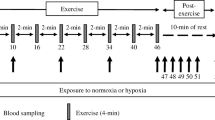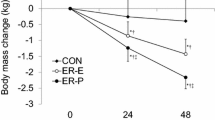Summary
It has recently been demonstrated that, compared to normal conditions, ventilation (\(\dot V_E \)) was increased during exercise after glycogen depletion, in spite of a marked increase in plasma pH (pHP). It was further demonstrated that\(\dot V_E \) in patients with McArdle's syndrome was reduced when substrate availability was improved. In the present experiments, six endurance trained men performed two successive cyclo-ergometric incremental exercise tests (tests A, B) after normal nutrition (N) and after a fatty meal in conjunction with a sodium bicarbonate (NaHCO3) solution (FSB) or without NaHCO3 (F), and the relationship between\(\dot V_E \), plasma potassium concentration ([K+]P), and pHP was checked. Plasma free fatty acid concentration ([FFA]P) was markedly increased in the F and FSB trials (P<0.001). In FSB pHP was significantly increased, compared to N and F (P<0.001). In all the B tests, pHP increased during moderate and intense exercise and in FSB, remained alkalotic even during maximal exercise intensity. In contrast,\(\dot V_E \) and [K+]P changes were almost equal in all the trials and in tests A and B. It was found that exercise-induced changes of\(\dot V_E \) and [K+]P in the present experiments were not markedly affected by [FFA]P or pHP values and that these changes also occurred independently of changes in pHP or plasma bicarbonate concentration. The often used glycogen depletion strategy may have slightly increased\(\dot V_E \) but apparently did not overcompensate for a possible decrease in\(\dot V_E \) due to increased pHP. The close relationship between\(\dot V_E \) and [K+]P was not affected by acid-base or substrate changes; this would further confirm the hypothesis that K+ may act as a stimulus for exercise\(\dot V_E \).
Similar content being viewed by others

References
Adler S (1987) Relationship between cell potassium and hydrogen ion in muscle. In: Bronner F, Kleinzeller A, Giebisch G (eds) Current topics in membranes and transport. vol. 28. Potassium transport: physiology and pathophysiology. Academic Press, New York, pp 421–440
Adrogue HC (1981) Changes in plasma potassium concentration during acute acid-base disturbances. Am J Med 71:456–467
Band DM, Linton RAF, Kent R, Kurer FL (1985) The effect of peripheral chemodenervation on the ventilatory response to potassium. Respir Physiol 60:217–225
Bergström J, Hermansen L, Hultman E, Saltin B (1967) Diet, muscle glycogen and physical performance. Acta Physiol Scand 71:140–150
Burger RE, Estavillo JA, Kumar P, Nye PCG, Paterson DJ (1988) Effects of potassium, oxygen and carbon dioxide on the steady state discharge of cat carotid body chemoreceptors. J Physiol (Lond) 401:519–531
Busse MW, Maassen N (1987) Ventilation and plasma potassium concentration during exercise. Pflügers Arch 408: S16
Busse MW, Maassen N (1989) Effect of consecutive exercise bouts on plasma potassium concentration during exercise and recovery. Med Sci Sports Exerc 21:489–493
Busse MW, Maassen N, Konrad H (1991) Relation between plasma K+ and ventilation during incremental exercise after glycogen depletion and repletion in man. J Physiol (Loud) 443:469–476
Ehnholm C, Kuusi T (1986) Preparation, characterization, and measurement of hepatic lipase. In: Colowick SP, Kaplan NO (eds) Methods in enzymology. vol. 129. Plasma lipoproteins, part B. Characterization, cell biology, and metabolism. Academic Press, New York, pp 716–719
Fraley DS, Adler S (1976) Isohydric regulation of plasma potassium by bicarbonate in the rat. Kidney Int 9:333–343
Fraley DS, Adler S (1977) Correction of hyperkalemia by bicarbonate despite constant blood pH. Kidney Int 12:354–360
Hagberg JM, Coyle EF, Carroll JE, Miller JE, Martin WH, Brooke MH (1982) Exercise hyperventilation in patients with McArdle's disease. J Appl Physiol 52:991–994
Haller G, Lewis SF (1986) Abnormal ventilation during exercise in McArdle's syndrome: modulation by substrate availability. Neurology 36:716–719
Heigenhauser GJF, Sutton JR, Jones NL (1983) Effect of glycogen depletion on the ventilatory response to exercise. J Appl Physiol 54:470–474
Kim WG, Brown EB (1968) Potassium transfer with constant extra-cellular pH. J Lab Clin Med 71:678–685
Kowalchuk JM, Heigenhauser GJF, Jones NL (1984) Effect of pH on metabolic and cardiorespiratory responses during progressive exercise. J Appl Physiol 57:1558–1563
Linton RAF, Band DM (1985) The effect of potassium on carotid chemoreceptor activity and ventilation in the cat. Respir Physiol 59:65–70
Oren A, Whipp BJ, Wasserman K (1982) Effect of acid-base status on the kinetics of the ventilatory response to moderate exercise. J Appl Physiol 52:1013–1017
Paterson DJ (1989) A role for potassium in the excitation of arterial chemoreceptors and the control of exercise hyperpnoea. Int J Sports Med 10:5102
Paterson DJ, Nye CG (1991) Effect of oxygen on potassium-excited ventilation in the decerebrate cat. Respir Physiol 84:223–230
Paterson DJ, Friedland JS, Bascom DA, Clement ID, Cunningham DA, Painter R, Robbins PA (1990) Changes in arterial K+ and ventilation during exercise in normal subjects and subjects with McArdle's syndrome. J Physiol (Lond) 429:339–348
Poulos AJ, Docter HJ, Westra HG (1974) Acid-base balance and subjective feelings of fatigue during physical exercise. Eur J Appl Physiol 33:207–213
Sherman WM, Costill DL, Fink WJ, Miller JM (1981) Effect of exercise-diet manipulation on muscle glycogen and its subsequent utilization during performance. Int J Sports Med 2:114–118
Wasserman K, Whipp BJ, Koyal SN, Cleary MG (1975) Effect of carotid body resection on ventilatory and acid-base control during exercise. J Appl Physiol 39:354–358
Author information
Authors and Affiliations
Rights and permissions
About this article
Cite this article
Busse, M.W., Scholz, J. & Maassen, N. Plasma potassium and ventilation during incremental exercise in humans: modulation by sodium bicarbonate and substrate availability. Europ. J. Appl. Physiol. 65, 340–346 (1992). https://doi.org/10.1007/BF00868138
Accepted:
Issue Date:
DOI: https://doi.org/10.1007/BF00868138



